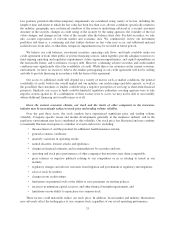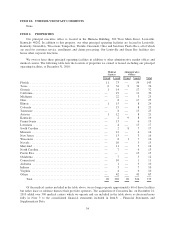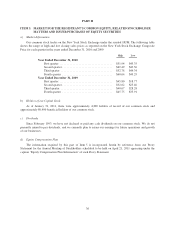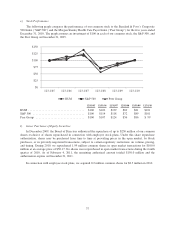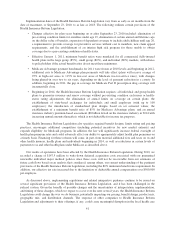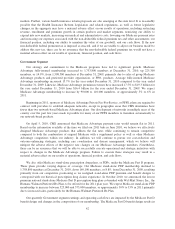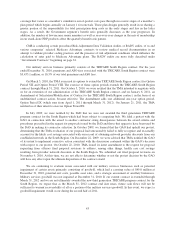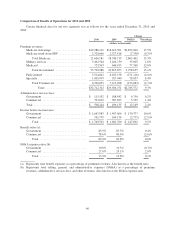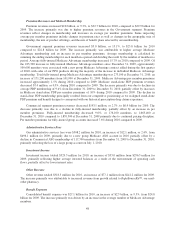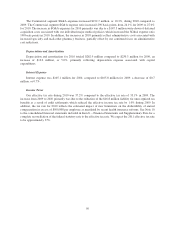Humana 2010 Annual Report Download - page 52
Download and view the complete annual report
Please find page 52 of the 2010 Humana annual report below. You can navigate through the pages in the report by either clicking on the pages listed below, or by using the keyword search tool below to find specific information within the annual report.markets. Further, various health insurance reform proposals are also emerging at the state level. It is reasonably
possible that the Health Insurance Reform Legislation and related regulations, as well as future legislative
changes, in the aggregate may have a material adverse effect on our results of operations, including restricting
revenue, enrollment and premium growth in certain products and market segments, restricting our ability to
expand into new markets, increasing our medical and administrative costs, lowering our Medicare payment rates
and increasing our expenses associated with the non-deductible federal premium tax and other assessments; our
financial position, including our ability to maintain the value of our goodwill; and our cash flows. If the new
non-deductible federal premium tax is imposed as enacted, and if we are unable to adjust our business model to
address this new tax, there can be no assurance that the non-deductible federal premium tax would not have a
material adverse effect on our results of operations, financial position, and cash flows.
Government Segment
Our strategy and commitment to the Medicare programs have led to significant growth. Medicare
Advantage fully-insured membership increased to 1,733,800 members at December 31, 2010, up 225,300
members, or 14.9%, from 1,508,500 members at December 31, 2009, primarily due to sales of group Medicare
Advantage products and preferred provider organization, or PPO, products. Average fully-insured Medicare
Advantage membership increased 15.7% for the year ended December 31, 2010 compared to the year ended
December 31, 2009. Likewise, Medicare Advantage premium revenues have increased 17.5% to $19.3 billion for
the year ended December 31, 2010 from $16.4 billion for the year ended December 31, 2009. We expect
Medicare Advantage membership to increase by 90,000 to 110,000 members, or approximately 5% to 6% in
2011.
Beginning in 2011, sponsors of Medicare Advantage Private Fee-For-Service, or PFFS, plans are required to
contract with providers to establish adequate networks, except in geographic areas that CMS determines have
fewer than two network-based Medicare Advantage plans. Our development of networks in multiple areas of the
country over the past few years made it possible for many of our PFFS members to transition automatically to
our network-based products.
On April 5, 2010, CMS announced that Medicare Advantage payment rates would remain flat in 2011.
Based on the information available at the time we filed our 2011 bids in June 2010, we believe we effectively
designed Medicare Advantage products that address the flat rates while continuing to remain competitive
compared to both the combination of original Medicare with a supplement policy as well as other Medicare
Advantage competitors within our industry. In addition, we will continue to pursue our cost-reduction and
outcome-enhancing strategies, including care coordination and disease management, which we believe will
mitigate the adverse effects of the negative rate changes on our Medicare Advantage members. Nonetheless,
there can be no assurance that we will be able to successfully execute operational and strategic initiatives with
respect to changes in the Medicare Advantage program. Failure to execute these strategies may result in a
material adverse effect on our results of operations, financial position, and cash flows.
We also offer Medicare stand-alone prescription drug plans, or PDPs, under the Medicare Part D program.
These plans provide varying degrees of coverage. Our Medicare stand-alone PDP membership declined to
1,758,800 members at December 31, 2010, down 169,100 members, or 8.8%, from December 31, 2009, resulting
primarily from our competitive positioning as we realigned stand-alone PDP premium and benefit designs to
correspond with our historical prescription drug claims experience. In October 2010, we announced the lowest
premium national stand-alone Medicare Part D prescription drug plan co-branded with Wal-Mart Stores, Inc., the
Humana Walmart-Preferred Rx Plan, to be offered for the 2011 plan year. We expect Medicare stand-alone PDP
membership to increase between 525,000 and 575,000 members, or approximately 30% to 33% in 2011 primarily
due to increased sales, particularly for the Humana Walmart-Preferred Rx Plan.
Our quarterly Government segment earnings and operating cash flows are impacted by the Medicare Part D
benefit design and changes in the composition of our membership. The Medicare Part D benefit design results in
42



